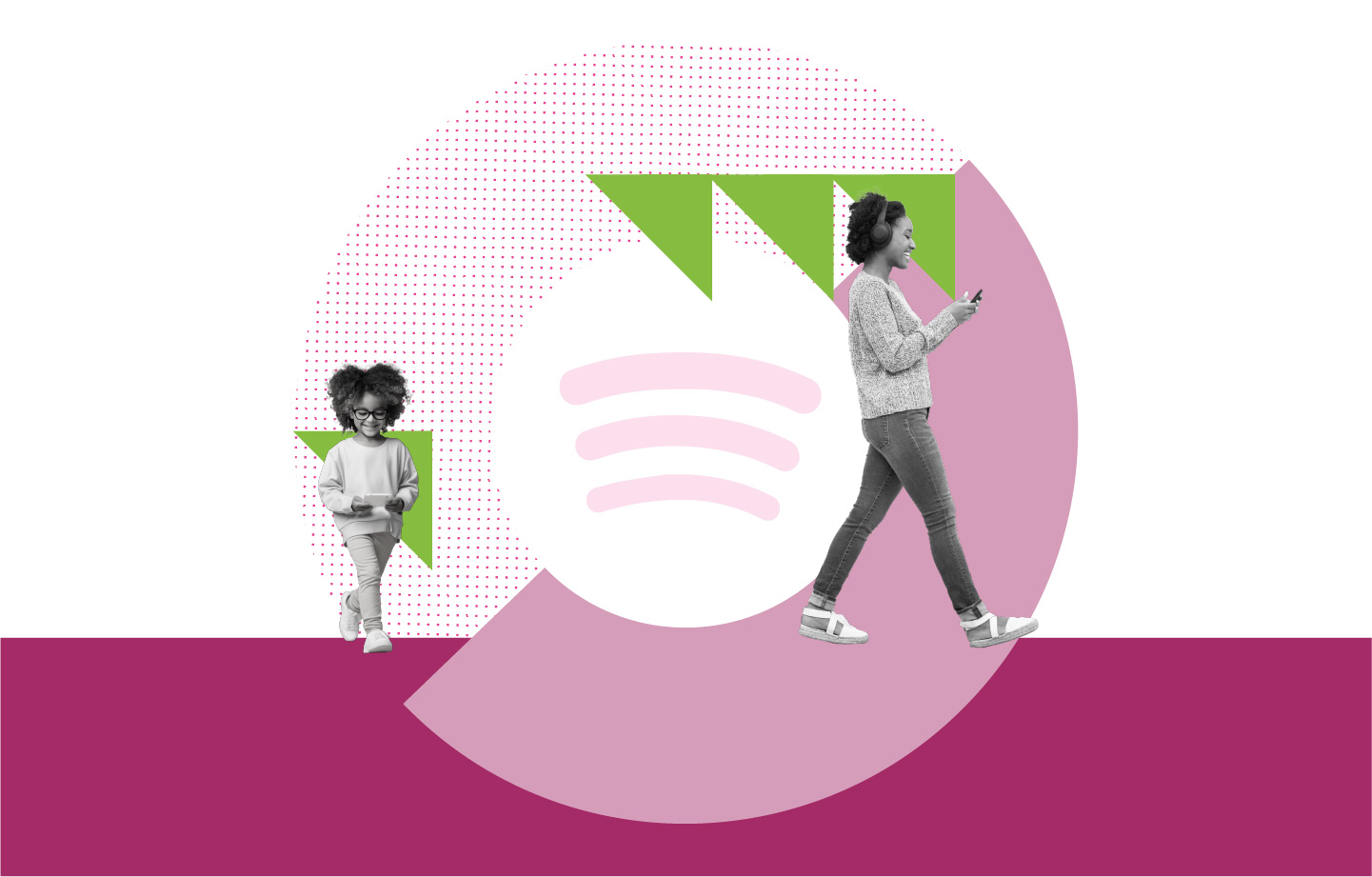Article
4 Ways Spotify’s “Wrapped” Builds Brand Loyalty


When Spotify users open their apps in the first week of December each year, they’re greeted with a notification that the annual “Wrapped” campaign has begun.
A top 5 list of the user’s most-listened-to songs of the year, accompanied by colorful animations and segments of their favorite songs. A map pinpointing the city that best represents the listening styles of the user. A radial flowchart illustrating the ways the user’s music tastes changed over the months of the year.
This isn’t the usual marketing campaign that most would skim through and close. Users are presented with a personalized, comprehensive roundup of all the songs, artists, podcasts and music genres that they have listened to over the past eleven months.
But more than a marketing campaign, Spotify’s “Wrapped” serves to build up the app’s brand in a way that other apps have never previously accomplished, and are only now trying to replicate. An extremely successful example of fulfilling a brand promise, the brand equity built by “Wrapped” makes the service more sticky and keeps users interested in using the app, moving beyond commoditization.
Below are 4 ways that “Wrapped” makes Spotify users bigger brand advocates, and why it exemplifies some top-tier branding practices that shouldn’t go unnoticed.
1. Surprising & Delighting Listeners
When Spotify released the first “Wrapped” campaign in December 2016, it was a surprise feature that immediately caught the attention of its audience. While Spotify had long been known to use personalized data for features like curated playlists and song recommendations, it had never offered such a comprehensive and intimate look at users’ own listening profiles.
Immediately, the “Wrapped” campaign went above and beyond the standard services that Spotify was known for. Rather than simply providing a platform for listening to music, the app was now telling users a story about themselves using the data collected from their own use.
It’s worth mentioning that, although Spotify has free and paid subscription tiers, all users receive the “Wrapped” roundup. The only prerequisite is having a registered Spotify account. This allows an even wider audience to join in on the fun and look at their own Wrapped data, comparing it with friends. By going beyond the typical services provided, Spotify was able to stand out from competitors such as Apple Music or Amazon Music.
This is a classic strategy of inbound marketing: surprising and delighting customers with content that goes beyond simple sales messages. “Wrapped” is not a campaign that explicitly asks users to sign up for a paid subscription, or even to listen to more music. But by providing a one-of-a-kind experience that (at first) was not offered by any other music streaming service, Spotify users began to perceive the brand with more excitement, anticipation and trust in future experiences.
Those who use other music streaming services, upon hearing about “Wrapped,” might seek out a Spotify account of their own volition, rather than because an advertisement told them to. Evidence seems to support this happening: each December, Spotify’s ranking in the App Store significantly increases. By pulling in people who had interest in Spotify’s services on their own, “Wrapped” makes Spotify more of a lifestyle choice than a choice of consumption.
2. Becoming a Topic of Conversation
The visual presentation of Spotify Wrapped is clearly reminiscent of social media features, highlighting the ability to share the campaign with friends. Since 2019, Spotify began modeling the campaign after social media stories: the report is structured around individual pages that users can tap through, similar to an Instagram story.
The idea here is clear: users are encouraged to download, screenshot or directly share their “Wrapped” roundup with friends and family via social media. The impact of the highly-shareable nature of Spotify Wrapped is that it starts viral conversations about the music everyone listens to.
Many have referred to this feature of “Wrapped” as “free advertising,” which it is: it makes it easy for more eyes to see the campaign in action and generate organic interest. But it also elevates part of Spotify’s brand into the cultural conversation. It allows Spotify, an app that isn’t exactly a social media service per se, to become a medium for conversations about the music people are enjoying, and the personalities associated with different music genres and artists.
The widespread discussion of “Wrapped” turns users of an app into a self-sustaining community that puts value on the campaign’s ability to, with measurable data, sort people into categories that reflect different music lifestyles. Fans of indie rock are able to band together against the diehard pop fanatics, and Swifties are able to quantify their fandom with exactly how many minutes they spent enjoying Taylor Swift’s latest album.
It also, in the words of Spotify’s head of global marketing, “creates a FOMO effect that inherently entices new users to consider Spotify.” When social media platforms become inundated with images of people’s top Spotify artists, it applies a social pressure to non-Spotify users to give the app a try.
3. Providing Value through Big Data
Tristan Harris, a former Google design ethicist, once said: “if you’re not paying for the product, you are the product.” The entire economy of data collection is built on this truth, and users are no longer naive to the ways their data is being collected and sold en masse.
While some have accepted that their data’s collection is necessary for the vast amount of features and systems that run our daily lives, for others, privacy is a major concern, and any data collection is met with skepticism.
But Spotify’s “Wrapped” campaign places a thumb on the scales toward a wider acceptance of personal data collection and sharing. It provides a transparent reveal of the sheer volume of information about each and every individual user collected by Spotify. And yet, the general public favorably accepts the value they get out of this data when “Wrapped” releases each year.
According to a report by Hightouch, “Wrapped” collects data to understand behavioral preferences such as:
- Who and what users like to listen to
- Metadata about users’ listening habits
- How users’ behavioral patterns change throughout the year
- Your device type (Android, iPhone, Desktop, SmartTV, etc.)
It collects this information across over 574 million users globally, most likely reaching into the exabytes (that’s one billion gigabytes) in the sheer mass of data the app collects in order for “Wrapped” to be possible.
But by turning that data into a feature for its users, it makes it a more palatable cost of entry for users. Fans of Spotify are not as concerned about personal data collection when they are able to benefit from it in the form of “Wrapped,” building a bond between brand and customer that allows Spotify to continue with its business practices with minimal blowback.
“Wrapped” also speaks to a certain level of transparency that provides a user with the “why” behind data collection. While personalized data collection sounds nefarious on paper, “Wrapped” showcases the potential benefits of this data and how users get a benefit from it, ultimately building up trust in Spotify’s brand.
4. Elevating Spotify’s Brand Beyond a Service
As a whole, “Wrapped” elevates the image of Spotify beyond a simple music streaming service. By providing a feature that delights and integrates the brand into a cultural discussion about the types of music people listen to, it shifts the brand into one that goes far beyond a transaction of money for music.
Many companies struggle to differentiate themselves with their brand, and instead engage in a race to the bottom with the lowest possible prices. But brands that can rise above that commoditization with meaningful branding have a longer-lasting impact on their customers.
Spotify’s “Wrapped” is an exemplary case study of this phenomenon. More than the price users have to pay to be able to listen to music, customers who enjoy “Wrapped” associate the Spotify brand with storytelling and the community that shares their yearly roundup on social media. It makes it harder to switch to another music streaming service, even if other services provide better subscription prices, simply because there’s a hesitation to lose out on the “Wrapped” experience.
Although “Wrapped” has proven to be extremely successful, Spotify has to continuously elevate the campaign to maintain the brand’s differentiation. A wide variety of companies now provide similar wrap-up campaigns at the end of the year, from Apple Music to PlayStation to GrubHub. Each year’s “Wrapped” now adds slightly different themes or elements to keep users interested and coming back.
Whether the “Wrapped” campaign can continue to hold on to its proponent’s attention for the years to come remains to be seen. But for the time being, it marks an accomplishment in branding that brings in new users and keeps current users invested in the identity they associate with Spotify’s brand.
Inspire Belief With Branding
If you want to learn more about how brands differentiate themselves with innovative strategies, browse our Insights blog. For more articles specifically on branding and brand strategy, check out these resources:




